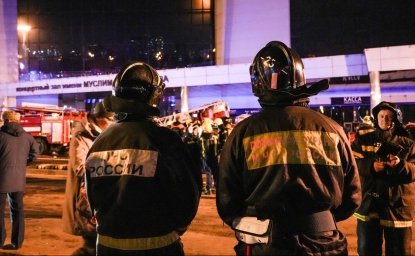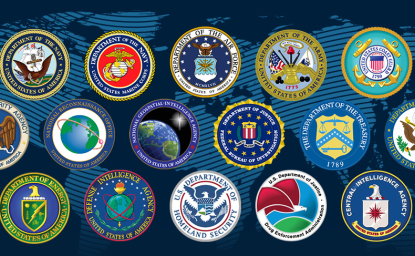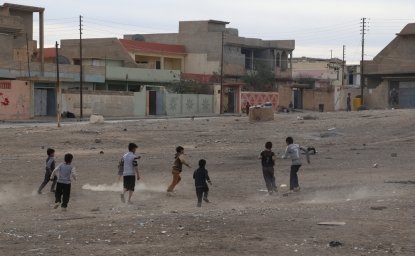In the twenty-first century, the most stunning development in radical Islamist ideology was the creation of the Islamic State in 2014. ISIS is a descendent of al-Qaeda, but it has propagated an interpretation of jihadism both more urgent and aggressive than any previous group’s.
ISIS emerged out of al-Qaeda in Iraq, which was founded (under a different name) in 1999 by Abu Musab al-Zarqawi, a Jordanian militant. His movement gained momentum after the U.S. intervention in 2003. He was killed in a U.S. airstrike in 2006. Even in its early days, al-Qaeda in Iraq engaged in brutal sectarian killings that al-Qaeda opposed as theologically illegitimate or potentially alienating to Sunni populations. Whereas al-Qaeda promoted a unified Islamic front against the West, al-Qaeda in Iraq prioritized killing Shiites and others it considered apostate Muslims who deserved death.
The group rebranded as the Islamic State of Iraq (ISI) in 2006. A joint campaign by Iraqi tribes and U.S. troops drove ISI from its strongholds between 2007 and 2011. Many core members were killed or imprisoned. In 2010, Abu Bakr al-Baghdadi, an Islamic scholar from Iraq, was selected as the group’s second leader. He had spent ten months in U.S. detention in 2004 before being released as a “low-level” detainee.

ISI spent several years rebuilding, with a wave of growth by 2013 that was facilitated by six factors: new internal leadership; a series of prison breaks that grew its ranks and put hardened jihadis back on the battlefield; a campaign of assassinations and intimidation to degrade Iraqi Security Forces; chaos created by the uprising in neighboring Syria; multiple political failures by the Iraqi government; and the U.S. withdrawal from Iraq.
In 2013, the group changed its name to the Islamic State of Iraq and al-Sham (ISIS); the change was part of an effort to affirm control over fighters it had dispatched to Syria in 2011 and to formally expand its statehood project into Syria. Many of the fighters defied the unilateral announcement by Abu Bakr al-Baghdadi and instead pledged allegiance to al-Qaeda’s leadership based in Pakistan and Afghanistan. A period of infighting ensued, despite efforts by al-Qaeda’s leadership to mediate the growing schism. In January 2014, ISIS seized the Syrian provincial capital of Raqqa from the Nusra Front and its allies. ISIS continued to pursue its nascent statehood project despite appeals for restraint from al-Qaeda and other jihadist organizations. In February 2014, al-Qaeda’s General Command severed ties with ISIS. The split has had a profound impact in the jihadi world.
In June 2014, ISIS formally announced a caliphate with its own government, economy, and army—usurping a longtime al-Qaeda goal albeit not in the same form. ISIS established a formal bureaucracy in the caliphate, with institutions based on its hard-line interpretation of Islam. By the end of 2016, the Pentagon said, between 27,000 and 31,000 foreign fighters—from eighty-six countries on five continents—had traveled to Iraq and Syria to join ISIS and other extremist groups. Other jihadists, including engineers, accountants, teachers, and families—also traveled to the caliphate. An estimated 90 percent of ISIS fighters in Iraq were of Iraqi origin. About 70 percent of ISIS fighters in Syria were of local origin, according to the Pentagon in late 2016.[2]
Strategy
ISIS seeks a war of attrition with the West in the Middle East and projects itself as the defender of Sunni Muslim communities. It has actively fomented local conflicts and sectarian tensions that work to its benefit. It has sought to present itself as the only Sunni militant group capable of fighting the government of Iraq and the only authentic jihadi group in Syria and, indeed, the world.
ISIS’s primary goal, unlike al-Qaeda’s, has been capturing and directly governing territory. The first issue of ISIS’s Dabiq magazine, published in July 2014, outlined a five-step process that includes setting up a base in a weak state, recruiting members, and fomenting local chaos. “This has always been the roadmap towards Khilafah (caliphate),” the magazine said. It criticized “other famous jihad groups”—presumably al-Qaeda—that did not prioritize capturing or ruling territory.[3] ISIS has been somewhat successful in appropriating and co-opting other groups, notably among Sunni tribal factions, forcing them to pledge baya—or allegiance—to Baghdadi. But it has few real alliances with other armed groups in Iraq or Syria. It has tended to act unilaterally.
In its caliphate, ISIS established court systems, schools, social services, and local governments. ISIS even had a publishing house to produce books, pamphlets, and textbooks for children. Foreign fighters occupied many administrative posts in the bureaucracy. ISIS initially attempted public outreach but also brutalized many in its own Sunni community as well as members of other sects. It engaged in mass killings of Yazidis, Shiites, and other minorities. In 2014, an ISIS publication boasted of “targeting apostates of all different backgrounds” and “never allowing any apostate group to enjoy a moment of security.”[4] ISIS beheaded prisoners and routinely posted images of their bodies on social media.
ISIS seeks a war of attrition with the West in the Middle East and projects itself as the defender of Sunni Muslim communities. It has actively fomented local conflicts and sectarian tensions that work to its benefit. It has sought to present itself as the only Sunni militant group capable of fighting the government of Iraq and the only authentic jihadi group in Syria and, indeed, the world.
Regionally, ISIS relied heavily on projecting ruthless strength and momentum as a strategy to win over sympathizers, particularly groups associated with al-Qaeda. Ansar Beit al-Maqdis in Egypt’s Sinai was among a few that declared allegiance to ISIS. But the core affiliates of rival al-Qaeda largely remained intact.
On the international stage, ISIS has carried out terrorist attacks in the West. The goal—a top priority—is to destabilize and undermine governments in Europe and the United States. ISIS has carried out mass killings at public gatherings, such as a theater and outdoor cafe in Paris in late 2015, and an airport in Brussels in early 2016. Its social media and slick publications have repeatedly appealed for lone-wolf attacks as well; they provide detailed instructions on how to construct homemade bombs and where to stab someone to ensure death.
Future
Breaking an eleven-month silence, Baghdadi released a half-hour message in November 2016 after Iraq, backed by the U.S.-led coalition, launched an offensive to recapture Mosul. He beseeched his followers in language that compared the battle over Mosul with the Prophet Muhammad’s campaign, when the first generation of Muslims was also outnumbered. “Do not run away from the battle,” the Islamic State leader said.
If you remain steadfast, God will support you and grant you victory and plant your feet firmly. Know that Paradise is under the shade of the swords. Know that even if some of your commanders have been killed, God will replace them with those who are the same or better.[5]
ISIS’s current model may not be sustainable, however, particularly under continued international pressure. Its bold tactics, hard-line ideology, and shocking violence initially won unprecedented territorial gains. Its focus on quick results allowed it to mobilize supporters and gain momentum. But its early gains led to quick losses. It failed to capture any new urban centers after May 2015.
By the end of 2016, ISIS had lost 43 percent of its total caliphate—57 percent of its territory in Iraq and 27 percent of its territory in Syria, according to the Pentagon. ISIS lost land under the twin pressure of ground offensives—carried out by disparate forces in Iraq and Syria—and daily airstrikes by a U.S.-led coalition.[6]
ISIS lost key cities in Iraq, including Ramadi, Fallujah, and Tikrit. The loss of Mosul—which accounts for about 11 percent of Iraq’s population—will eliminate all major population centers under ISIS control in Iraq. In Syria, ISIS lost Kobani, Tal Abyad, and Hasaka, as well as Manbij, a city that served as its strategic resupply route to Turkey.
For ISIS, the death toll has been staggering. A U.S. commander in Iraq estimated that 45,000 ISIS fighters had been “taken off the battlefield” by August 2016.[7] By November, the United States estimated that another 800 to 900 had been killed in the first ten days of the campaign to liberate Mosul. At least 120 senior leaders were eliminated, mostly in airstrikes, including the chief of foreign operations, deputy emirs, the minister of information, and a member of the ruling Shura Council.[8] ISIS financial assets were also depleted by airstrikes on oil facilities, oil tankers, and warehouses used to store cash.
There are at least six future scenarios for ISIS. They are not all mutually exclusive.
ISIS’s current model may not be sustainable, however, particularly under continued international pressure. Its bold tactics, hard-line ideology, and shocking violence initially won unprecedented territorial gains. Its focus on quick results allowed it to mobilize supporters and gain momentum. But its early gains led to quick losses. It failed to capture any new urban centers after May 2015.

First is a diminished status quo. ISIS could retain some of its territory, but with its capabilities markedly degraded. Despite loss of territory, its fighters have repeatedly demonstrated discipline, cohesion, and a willingness to fight even when outmanned, outgunned, and unable to counter the airpower of the U.S.-led coalition. The ISIS brand may still resonate because the movement originally made unprecedented territorial gains and achieved global notoriety.
Second, the caliphate could continue to contract. By the end of 2016, the Islamic State’s longevity was in doubt because of growing military and financial pressure. The loss of momentum—which was a key factor thrusting ISIS into the global spotlight and allowing it to dominate the jihadist agenda for two years—exacerbated the physical loss of territory.
ISIS’s brutality may also tarnish its brand. Its predecessor, al-Qaeda in Iraq, experienced a similar phenomenon in 2006. Its violence and usurpation of economic activity (through smuggling and extortion) alienated many Iraqi Sunnis in Anbar and Ninewa Provinces, who then partnered with the United States to counter the al-Qaeda affiliate.
Third, ISIS’s next move may be an “inhiyaz ila al sahra” or a retreat into the desert, as forecast by Abu Mohammad al-Adnani, chief of external operations, before he was killed in a U.S. airstrike in August. In the summer of 2016, he insisted that ISIS could lose all its territory and still survive—and even come back stronger. The loss of territory may slow or reverse ISIS’s growth. But it still has “virtual jihadism” in prolific propaganda published in dozens of languages across cyber and social media platforms.
The hardest-core fighters may remain committed to ISIS, but the disillusioned may opt to join other jihadi movements, either in Middle East theaters or in Muslim conflict zones further afield.
The organization is certain to survive in altered physical form too, perhaps as a more traditional terrorist organization. Elimination of the group’s territory may not fundamentally undermine its endurance. ISIS would still be able to exploit Sunni discontent and foment sectarian tension over the next five to ten years in Iraq, Syria, Libya, and potentially beyond. It is already showing signs that it can and will go back to the strategy favored between 2007 and 2011, when it was an insurgency destabilizing the weak Iraqi government, carrying out attacks that inflicted mass casualties, and undermining U.S. interests in the Middle East.
ISIS’s Rumiyah magazine on jihad. Image from Al-Hayat Media Center.
Indeed, the conditions in Iraq today could be more favorable for the revival of ISIS--if and when it is defeated territorially—than the conditions in 2007, when its predecessor was driven out of Iraqi towns with the help of the American surge and the local tribal uprising. The favorable conditions include deeper fractures along sectarian, social, political, and ethnic lines. Compared to 2007, the government in Baghdad is seen as dominated by sectarian politicos and ragtag Iranian-backed Shiite militias—and unresponsive to Iraq’s Sunnis. ISIS can retreat into remote areas of the desert or along river banks that would facilitate its movement, flow of arms, and operations.
Fourth, ISIS fighters could relocate, either physically or politically. They may attempt to blend back into their own societies, at least for the short term. The hardest-core fighters may remain committed to ISIS, but the disillusioned may opt to join other jihadi movements, either in Middle East theaters or in Muslim conflict zones further afield. In Syria, local jihadis forced out of Raqqa and other ISIS-held territory may consider joining Jabhat Fateh al-Sham, the al-Qaeda franchise, or other extremist militias. ISIS could also seek to expand into western Syria.
Fifth, ISIS could shift focus beyond the Middle East. It still has global reach. In just two years, it spawned a network of affiliates and sympathizers capable of carrying out deadly attacks worldwide, including in Europe and the United States—although probably only a small subset was capable of coordinating with ISIS. At its height in 2016, dozens of armed groups on three continents had pledged allegiance to ISIS, although the Islamic State did not formally embrace them all. It had particularly active branches in Libya, Egypt, Afghanistan, and Pakistan. In 2015 and 2016, its fighters and sympathizers killed at least 1,200 people outside of its arena of operations in Iraq and Syria.
In his November 2016 message, Baghdadi specifically appealed to the caliphate’s “soldiers” beyond Iraq and Syria to take their own actions in Algeria, the Arabian Peninsula, Bangladesh, the Caucasus, Egypt, Indonesia, the Khorasan region (or Afghanistan and Pakistan), Libya, the Philippines, the Sinai, Somalia, Tunisia, West Africa, and Yemen.
“Know that today you are the pillars of Islam on earth and the poles of the Caliphate in it. You have startled the nations of unbelief with your jihad, your patience, and your steadfastness,” he said.
They are striving to extinguish the light of God among you, by spreading causes of disunity and disagreement. We will not neglect, at this opportunity, to remind all our Muslim brothers that if the paths have become restricted and the routes of migration to Iraq and Syria cut off, then God has made a wide path for them to migrate to those blessed provinces to establish there a fortress of Islam.[9]
Sixth, ISIS may increasingly focus on the United States, which has led a coalition of more than 60 nations against the movement. In the third issue of Rumiyah, its slick online magazine, ISIS provided detailed instructions for lone-wolf attacks in the United States. The November 2016 issue recommended targeting outdoor celebrations, festivals, political rallies, and parades—and ran a photo of the Macy’s Thanksgiving Day Parade as an example.
In language that recalled the July 2016 attack in Nice, France, Rumiyah specifically advised,
The method of such an attack is that a vehicle is plunged at a high speed into a large congregation of (nonbelievers), smashing their bodies with the vehicle’s strong outer frame while advancing forward—crushing their heads, torsos, and limbs under the vehicle’s wheels and chassis—and leaving behind a trail of carnage.[10]
List of Branches
The Islamic State views itself as a global movement with eight formal branches, divided into 37 wilayats or provinces, which have pledged allegiance to the caliphate. The active provinces tend to be well organized; some communicate with each other. The movement has published or broadcast in 35 languages, including Mauritian Creole. The caliphate does not have total control over all its provinces, however. And some provinces are weak or dormant or have been crushed by the state.

The Islamic State has also cultivated looser networks of cells, operatives, and sympathizers in Europe, Asia, Africa, and the United States. Its network in Turkey facilitated the flow of fighters, weapons, resources, and even oil exports. Cells in Europe carried out terrorist spectaculars in Brussels and Paris. Sympathizers in the United States were responsible for mass shootings in California and Florida. The Islamic State’s formal provinces include the following:
Yemen (eight provinces): Pledged allegiance in September–November 2014.[11]
- Aden-Abyan Province (in the southwest)
- Hadrawmat Province (in the east)
- Sana’a Province (capital) (dormant)
- Green Brigade Province (in southern Ibb and Taiz) (dormant)
- Bayda Province (in the center) (dormant)
- Shabwah Province (in the east) (dormant)
- Lahij Province (in the south) (dormant)
- Ataq Province (in the southwest) (dormant)
Saudi Arabia (three provinces): Pledged allegiance in November 2014.[12]
- Najd Province (in the center)
- Hijaz Province (in the west)
- Bahrain Province (in the east)
Algeria (one province): Formed from an al-Qaeda in the Islamic Maghreb (AQIM) breakaway group known as Jund al-Khilafah; pledged allegiance in September 2014.[13]
- Al-Jaza’ir Province
Libya (three provinces): Founded in early 2014 as Islamic Youth Shura Council;[14] pledged allegiance in October 2014.[15]
- Barqa Province (Derna and Benghazi in the east)
- Tarabalus Province (around Sirte in the west)
- Fezzan Province (in the south)
Egypt (one province): Founded as Ansar Beit al-Maqdis in 2011; pledged allegiance in November 2014.[16]
- Sinai Province (in the north)
Nigeria (one province): Founded as Boko Haram (its formal title translates as “People Committed to the Prophet’s Teachings for Propagation and Jihad”) in 2002; pledged allegiance in March 2015;[17] since that time has splintered.
- Gharb Ifriqiyya Province (West Africa)
Caucasus (one province): Formed by Islamic Emirate of the Caucasus (IEC) defectors; pledged allegiance in June 2015.[18]
- Qawqaz Province
Afghanistan/Pakistan (one province): Breakaway formed from Tehreek-e-Taliban Pakistan (TTP); pledged allegiance to ISIS in January 2015.[19]
- Khorasan Province (South Asia)
[2]. Senior U.S. defense official, November 12, 2016, citing Soufan Group, “Foreign Fighters: An Updated Assessment of the Flow of Foreign Fighters into Syria and Iraq,” December 2015, soufangroup.com/wp-content/uploads/2015/12/TSG_ForeignFightersUpdate3.pdf.
[3]. “From Hijrah to Khilafah,” Dabiq, no. 1 (July 2014), azelin.files.wordpress.com/2014/07/islamic-state-22dc481biq-magazine-122.pdf.
[4]. Ibid.
[5]. MEMRI Jihad and Terrorism Threat Monitor (JTTM), “ISIS Leader Al-Baghdadi Responds to Military Campaign to Retake Mosul, Urges ISIS Soldiers to Remain Strong, Calls for Attacks on ISIS's Enemies,” November 2, 2016, www.memrijttm.org/isis-leader-al-baghdadi-responds-to-military-campaign-to-retake-mosul-urges-isis-soldiers-to-remain-strong-calls-for-attacks-on-isiss-enemies.html.
[6]. Senior U.S. defense official, November 12, 2016.
[7]. Commander of Combined Joint Task Force—Operation Inherent Resolve, Lieutenant General Sean MacFarland, U.S. Department of Defense Press Briefing, August 10, 2016, www.defense.gov/News/Transcripts/Transcript-View/Article/911009/department-of-defense-press-briefing-by-lieutenant-general-sean-macfarland-comm.
[8]. Eugene Scott, “General: Up to 900 ISIS Fighters Killed in Battle for Mosul,” CNN, October 28, 2016, www.cnn.com/2016/10/27/politics/mosul-isis-donald-trump/.
[9]. MEMRI Jihad and Terrorism Threat Monitor (JTTM), “ISIS Leader Al-Baghdadi Responds to Military Campaign to Retake Mosul.”
[10]. “Just Terror Tactics,” Rumiyah, no. 3 (November 2016), pietervanostaeyen.files.wordpress.com/2016/11/rumiyah3en.pdf.
[11]. Terrorism Research & Analysis Consortium (TRAC), “Islamic State in Yemen (ISY, ISISY) and Islamic State Saudi Arabia (ISKSA, ISISKSA),” accessed November 15, 2016, www.trackingterrorism.org/group/islamic-state-yemen-isy-isisy-and-islamic-state-saudi-arabia-isksa-isisksa.
[12]. Global Security, “Wilayat Najd (Najd Province),” accessed November 15, 2016, www.globalsecurity.org/military/world/para/wilayat-najd.htm.
[13]. Harleen Gambhir, “ISIS Global Intelligence Summary March 1–May 7, 2015,” Institute for the Study of War, May 10, 2015, www.understandingwar.org/sites/default/files/ISIS%20INTSUM_Final.pdf.
[14]. Aaron Y. Zelin, “The Islamic State's Archipelago of Provinces,” Washington Institute for Near East Policy, November 14, 2014, www.washingtoninstitute.org/policy-analysis/view/the-islamic-states-archipelago-of-provinces.
[15]. Cody Zoschak and Harleen Gambhir, “ISIS Loses Libyan Stronghold,” Institute for the Study of War, June 24, 2015, www.understandingwar.org/backgrounder/isis-loses-libyan-stronghold.
[16]. Mapping Militant Organizations, “The Islamic State—Sinai Province,” Stanford University, last modified February 28, 2016, web.stanford.edu/group/mappingmilitants/cgi-bin/groups/view/557.
[17]. Mapping Militant Organizations, “Boko Haram,” Stanford University, last modified August 26, 2016, web.stanford.edu/group/mappingmilitants/cgi-bin/groups/view/553.
[18]. Harleen Gambhir, “ISIS Declares Governorate in Russia's North Caucasus Region,” Institute for the Study of War, June 23, 2015, understandingwar.org/backgrounder/isis-declares-governorate-russia%E2%80%99s-north-caucasus-region.
[19]. FDD’s Long War Journal, “Pakistani Taliban Splinter Group Again Pledges Allegiance to Islamic State,” January 13, 2015, www.longwarjournal.org/archives/2015/01/video_pakistani_tali_2.php.
Contributor


The Islamists
Learn more about Hamas and how it relates to similarly aligned organizations throughout the region. Read more

Explore More
Browse Insights & Analysis
The Jihadi Threat: ISIS, al-Qaeda, and Beyond

An Act of Terror Cannot Occur on Russian Soil

